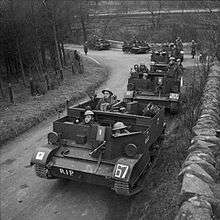46th Infantry Division (United Kingdom)
| 46th Infantry Division | |
|---|---|
 Formation sign of the 46th Infantry Division. | |
| Active | 1939–1946 |
| Country |
|
| Branch |
|
| Type | Infantry |
| Size | Division |
| Nickname(s) |
"The Oak Tree Division" "The Iron Division" |
| Engagements | World War II |
| Commanders | |
| Notable commanders |
Charles Hudson Douglas Wimberley Sir Miles Dempsey Sir John Hawkesworth |
The 46th Infantry Division was an infantry division of the British Army raised in 1939 that saw distinguished service during World War II, fighting in the Battle of France and the Battle of Dunkirk where it was evacuated and later in North Africa, Italy and Greece.
Formation
1939−1940
Throughout the spring and summer of 1939, the Territorial Army (TA) was ordered to be doubled in size, as the threat of a European war with Nazi Germany was increasing. As a result, the 46th Infantry Division came into existence in April 1939 as the 2nd Line duplicate of the 49th (West Riding) Infantry Division, although the headquarters of 46th Division did not assume command until 2 October 1939, slightly less than a month after World War II began. The division's first General Officer Commanding (GOC) was Major-General Algernon Lee Ransome.[1] Like its parent 49th Division, the 46th drew men primarily from the North Midlands and the West Riding areas of England[2] and initially consisted of the 137th, 138th and 139th Infantry Brigades, together with supporting units.[3]
In late April 1940 the 46th Infantry Division, now commanded by Major-General Henry Curtis,[1] was sent to France to join the British Expeditionary Force (BEF). [2] The division arrived on 24 April, came under command of HQ lines of communication, BEF, alongside the 12th (Eastern) and 23rd (Northumbrian) Divisions.[4] As it was poorly trained and lacked most of its artillery and signals units, it was assigned as a labour and training unit. Nevertheless, it ended up suffering very heavy casualties fighting the German Army in the Battle of France and, with the rest of the BEF, was forced to retreat to Dunkirk and was evacuated to Britain.[2] However, the 2/6th Battalion, Duke of Wellington's Regiment, of the 137th Infantry Brigade were not evacuated with the rest of the division as they had been cut off when the Germans cut through Northern France and were instead attached to 'A' Infantry Brigade, previously the 25th Infantry Brigade, of the Beauman Division and later under command of the 51st (Highland) Infantry Division. The battalion later managed to avoid the surrender of the 51st (Highland) and around 500 men were successfully evacuated to the United Kingdom.[2]
1940−1943

Upon returning to the United Kingdom, the 46th Division, now under Major General Desmond Anderson,[1] was sent to Scotland where it served under Scottish Command and, due to the heavy casualties it suffered, was reformed with large numbers of conscripts. Most of the rest of 1940 was spent training to repel a German invasion and, in mid-December, the division received a new GOC, Major General Charles Hudson, a highly distinguished World War I veteran, and a recipient of the Victoria Cross (VC).[1] Soon afterwards, in early January 1941, the division was sent to East Anglia, where it came under command of II Corps,[4] under Lieutenant General Edmund Osborne, itself under Eastern Command, and continued its anti-invasion duties.[2] In late 1941 the division was sent to Kent, where it came under command of XII Corps, then commanded by Lieutenant General Bernard Montgomery, but soon replaced by Lieutenant General James Gammell after Montgomery was promoted to South-Eastern Command, under which XII Corps was serving. Under Montgomery the division commenced very strenuous large-scale field exercises.[2] Throughout 1941 the division went through several changes in command, with Major General Hudson being succeeded on 22 May by Major General Douglas Wimberley, who was in command only for three weeks before Major General Miles Dempsey became GOC; he in turn was succeeded on 3 November by Major General Harold Freeman-Attwood, who remained until August 1943.[1]
In mid-1942, it was decided to reorganise the division as a 'mixed' division and thus, on 20 July 1942, the 137th Infantry Brigade left the division to begin its conversion to armour as the 137th Armoured Brigade. The following month, however, there was a change of plan; the division was to remain as an infantry division and the 128th Infantry Brigade, from the 43rd (Wessex) Division, was reassigned to the 46th. The division remained with XII Corps until 15 August 1942, where it came under control of the War Office and, on 24 August, came under command of the British First Army, under Lieutenant General Sir Kenneth Anderson, then being formed for Operation Torch.[5][2][4]
1943−1945

The division left the United Kingdom on 6 January 1943 to fight in the final stages of the North African Campaign. The 46th arrived in Tunisia on 17 January and fought in the Tunisian Campaign, with elements of the division, serving as part of Lieutenant General Charles Allfrey's V Corps, part of the British First Army,[4] taking part in the Battle of Sedjenane. The division, Brigadier Manley James's 128th Brigade in particular, later bore the brunt of a major German offensive, Operation Ochsenkopf. The campaign finally came to an end in May 1943, with the surrender of nearly 250,000 German and Italian soldiers becoming prisoners of war (POWs).[2]

From there on the 46th Division, from August under the command of Major-General John Hawkesworth, fought throughout the Italian Campaign in late 1943 with both the U.S. Fifth Army and the British Eighth Army, fighting in tough battles such as that at the initial Salerno landings in September 1943, followed by fighting at the Volturno Line, the Winter Line, the Bernhardt Line, First Battle of Monte Cassino and later the Gothic Line. During the fighting in Italy the 46th Division suffered over 9,200 casualties, including 1,447 officers and men killed in action, with a further 6,476 wounded and 1,957 missing.[6]
In late December/early 1945, the division, now commanded by Major-General Stephen Weir, a New Zealand Army officer, was sent to re-occupy Greece, where they came under command of Lieutenant-General Ronald Scobie's III Corps.
The formation sign worn by members of the 46th Division during the war bore a Sherwood Forest oak tree.[2]
Order of battle
The 46th Infantry Division was constituted as follows during the war:[7]
137th Infantry Brigade (left 20 July 1942)[8]
- 2/5th Battalion, West Yorkshire Regiment
- 2/6th Battalion, Duke of Wellington's Regiment
- 2/7th Battalion, Duke of Wellington's Regiment
- 137th Infantry Brigade Anti-Tank Company (formed 12 July 1940, disbanded 28 November 1941)
- 6th Battalion, Lincolnshire Regiment
- 2/4th Battalion, King's Own Yorkshire Light Infantry
- 6th Battalion, York and Lancaster Regiment
- 138th Infantry Brigade Anti-Tank Company (formed 22 July 1940, disbanded 10 July 1941)
- 2/5th Battalion, Leicestershire Regiment
- 2/5th Battalion, Sherwood Foresters (redesignated 5th Battalion on 1 March 1943)
- 9th Battalion, Sherwood Foresters (to 28 December 1940)
- 139th Infantry Brigade Anti-Tank Company (formed 17 August 1940, disbanded 10 July 1941)
- 16th Battalion, Durham Light Infantry (from 28 December 1940)
137th Armoured Brigade (from 20 July 1942, left 14 August 1942)[11]
- 113th Regiment Royal Armoured Corps
- 114th Regiment Royal Armoured Corps
- 115th Regiment Royal Armoured Corps
128th Infantry Brigade (from 15 August 1942) [12]
- 1/4th Battalion, Hampshire Regiment
- 5th Battalion, Hampshire Regiment
- 2/4th Battalion, Hampshire Regiment (left 9 May 1943)
- 2nd Battalion Hampshire Regiment (from 10 May 1943)
Divisional Troops
- 2/7th Battalion, Middlesex Regiment (from 11 November 1941, left 1 October 1942)
- 2nd Battalion, Royal Northumberland Fusiliers (from 3 July 1943, left 10 March 1944)
- 9th Battalion, Manchester Regiment (from 15 July 1944)
- 46th Battalion, Reconnaissance Corps (formed 11 July 1941, redesignated 46th Regiment, Reconnaissance Corps 6 June 1942, became 46th Regiment, Royal Armoured Corps 1 January 1944)
- 121st (West Riding) Field Regiment, Royal Artillery (left 12 July 1940)
- 122nd (West Riding) Field Regiment, Royal Artillery (left 12 July 1940)
- 123rd (West Riding) Field Regiment, Royal Artillery (left 12 July 1940)
- 70th (West Riding) Field Regiment, Royal Artillery (from 30 July 1940)
- 71st (West Riding) Field Regiment, Royal Artillery (from 30 July 1940)
- 51st (Westmoreland and Cumberland Yeomanry) Field Regiment, Royal Artillery (from 30 July 1940, left 16 September 1940)
- 151st (Ayrshire Yeomanry) Field Regiment, Royal Artillery (from 16 September 1940, left 10 May 1942)
- 172nd Field Regiment, Royal Artillery (from 11 May 1942)
- 58th (The Duke of Wellington's) Anti-Tank Regiment, Royal Artillery (to 30 June 1940)
- 68th Anti-Tank Regiment, Royal Artillery (from 30 July 1940)
- 115th (East Yorks) Light Anti-Aircraft Regiment, Royal Artillery (from 24 February 1942, disbanded 8 November 1944)
- 270th Field Company, Royal Engineers
- 271st Field Company, Royal Engineers
- 272nd Field Company, Royal Engineers
- 273rd Field Park Company, Royal Engineers
- 201st Bridging Platoon, Royal Engineers (from 4 April 1944)
- 46th Divisional Signals Regiment, Royal Corps of Signals
General Officer Commanding
- Major-General Algernon L. Ransome: October–December 1939
- Major-General Henry O. Curtis: December 1939-June 1940
- Major-General Desmond F. Anderson: June–December 1940
- Major-General Charles E. Hudson: December 1940-May 1941
- Major-General Douglas N. Wimberley: May–June 1941
- Major-General Miles C. Dempsey: June–October 1941
- Major-General Harold A. Freeman-Attwood: November 1941–August 1943
- Major-General John L.I. Hawkesworth: August 1943–November 1944
- Major-General Stephen C.E. Weir: November 1944–September 1946
- Major-General John F.B. Combe: September 1946 – 1947
Victoria Cross recipients
- Lieutenant Gerard Ross Norton, attached to 1/4th Battalion, Hampshire Regiment
- Captain John Brunt, Sherwood Foresters, attached to 6th Battalion, Lincolnshire Regiment
See also
- List of British divisions in World War II
- British Army Order of Battle (September 1939)
- 46th (North Midland) Division; a British Army First World War formation
- 49th (West Riding) Infantry Division; 1st Line parent formation
References
- 1 2 3 4 5 Joslen, p. 75
- 1 2 3 4 5 6 7 8 9 "badge, formation, 46th (North Midland and West Riding) Infantry Division". Imperial War Museum. Retrieved 10 July 2017.
- ↑ "46th Infantry Division (1939)" (PDF). British military history. Retrieved 3 February 2017.
- 1 2 3 4 Joslen, p. 76
- ↑ "46th Infantry Division (1942-43)" (PDF). British military history. Retrieved 3 February 2017.
- ↑ Anon p. 66
- ↑ Joslen, pps. 75-76
- ↑ Joslen, p. 323
- ↑ Joslen, p. 324
- ↑ Joslen, p. 326-326
- ↑ Joslen, p. 188
- ↑ Joslen, p. 313
External links
Bibliography
- Anonymous, The Story of 46 Division 1939–1945
- Lt-Col H.F. Joslen, Orders of Battle, United Kingdom and Colonial Formations and Units in the Second World War, 1939–1945, London: HM Stationery Office, 1960/Uckfield: Naval & Military, 2003, ISBN 1-84342-474-6.